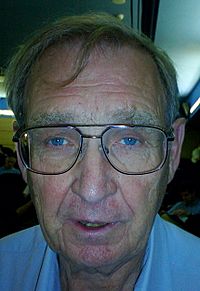Hans Frauenfelder facts for kids
Quick facts for kids
Hans Frauenfelder
|
|
|---|---|
 |
|
| Born | July 28, 1922 |
| Died | July 10, 2022 (aged 99) Tesuque, New Mexico, U.S.
|
| Citizenship | American |
| Alma mater | Swiss Federal Institute of Technology |
| Known for | Perturbed angular correlation protein folding and dynamics |
| Awards | Max Delbruck Prize (1992) Richtmyer Memorial Award (1981) Racah Lecture (1984) Guggenheim Fellowship (1958) |
| Scientific career | |
| Fields | Physicist |
| Institutions | Los Alamos National Laboratory University of Illinois at Urbana-Champaign |
| Doctoral advisor | Paul Scherrer |
| Other academic advisors | Gregor Wentzel Wolfgang Pauli |
Hans Frauenfelder (born July 28, 1922 – died July 10, 2022) was an American scientist. He was a physicist and a biophysicist. He is famous for discovering something called perturbed angular correlation (PAC) in 1951. Today, PAC spectroscopy is used a lot to study how different materials behave. In biophysics, which is the study of physics in living things, he was known for his research on how proteins fold and move.
Contents
Learning and Early Discoveries
Hans Frauenfelder earned his science doctorate (Dr. sc. nat.) in physics in 1950. He studied at the Swiss Federal Institute of Technology in Zurich, Switzerland. His main teacher was Paul Scherrer. Hans's final project was about studying radioactive surfaces.
At ETH, he also learned from famous scientists like Gregor Wentzel and Wolfgang Pauli. Through Pauli, he met many other important scientists. These included Hendrik Kramers, Werner Heisenberg, Hans Jensen, and Wolfgang Paul.
A Career in Science
In 1952, Frauenfelder moved to the United States. He joined the Physics Department at the University of Illinois at Urbana-Champaign (UIUC). He worked there as a research associate. He stayed at UIUC until 1992. Eventually, he became a special professor of Physics, Chemistry, and Biophysics.
Research Interests
Frauenfelder was interested in many areas of science. His research included:
- Nuclear physics (the study of atomic nuclei)
- Particle physics (the study of tiny particles)
- Conservation laws (rules about what stays the same in nature)
- The Mössbauer effect (a way to study materials using gamma rays)
- The biophysics of protein folding and how proteins move.
Working with CERN
Frauenfelder was a visiting scientist at the European Organization for Nuclear Research (CERN). He visited in 1958/59, 1963, and 1973. CERN is a very large research center where scientists study the basic building blocks of matter.
Later Work at Los Alamos
In 1992, Frauenfelder moved to the Los Alamos National Laboratory. There, he led the Center for Nonlinear Studies (CNLS) until 1997. After that, he joined a group at Los Alamos that studied theoretical biology and biophysics. He continued his research in biophysics there.
Frauenfelder Rules
Hans Frauenfelder also created the "Frauenfelder Rules." These are guidelines for how to run a successful science seminar or workshop. According to his rules, a presentation should only take up about 66% of the time. The rest of the time should be used for questions and deep discussions. This helps everyone learn more and share ideas better.
Personal Life
Hans Frauenfelder passed away in Tesuque, New Mexico, on July 10, 2022. This was just eighteen days before his 100th birthday.
Awards and Recognition
Frauenfelder received many honors for his scientific work:
- He was chosen as a Fellow of the American Physical Society in 1961.
- He became a member of the National Academy of Sciences in 1975. This is a very important group of top scientists in the United States.
- He was also a member of the American Philosophical Society.
- He became a Foreign Member of the Royal Swedish Academy of Sciences.
See also
- Wolfgang Pauli
- Paul Scherrer
- Quantum Aspects of Life

